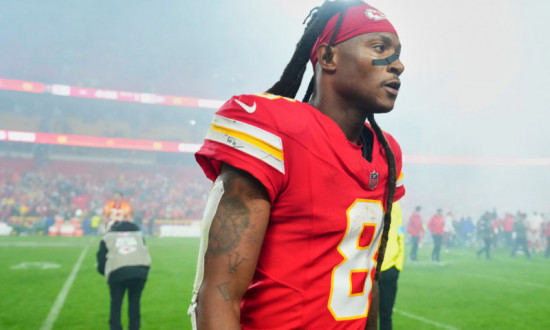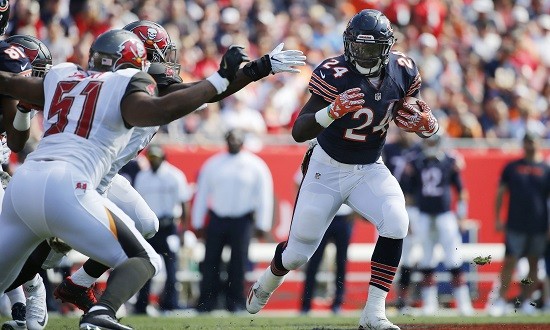Raybon's Rollout: Week 10
Welcome back to Raybon’s Rollout, where I highlight the unconventional stacks and players I’ll be rolling out in DFS each week.
The column is largely based on my intensive research on stacking and coaching tendencies, and this year I’m adding a section that features the player with the top projected percentage odds of the week to hit cash game value, which follows the same methodology I use to calculate projected odds of hitting tournament value in my GPP Leverage Score metric.
Unconventional Stacks
RB Matt Forte + WR Robby Anderson
Forte (knee) has been ruled out for Week 10, Bilal Powell looks like the better option for this stack. Powell is likely to take on an added role in the receiving game with Forte out, and has shown the ability to break long runs, with a 51-yarder last week, a 25-yarder in Week 7, and a 75-yarder in Week 4.
One of the best ways to find potential stacks is to pair players that allow you to cheaply invest into a large chunk of an offense’s production in a good matchup. The Buccaneers have allowed more schedule-adjusted fantasy points to opposing offenses than any other team in football, and no member of the Jets offense costs more than $6,500 on FanDuel or $5,200 on DraftKings except quarterback Josh McCown ($6,100, $7,400). McCown is certainly a viable addition to this stack, but simply pairing Forte and Anderson is even more cost-effective and allows for more wiggle room if Forte rushes for a TD or two.
Over the past four weeks, Forte and Anderson have combined to account for 43.1% of the Jets FanDuel points and 42.9% of their DraftKings points, with both averaging more than 16.0 DraftKings points and 13.0 FanDuel points during that span. Since returning from injury in Week 6, Forte has carved out a role as the leader of the Jets backfield committee, which has translated into 14.3 total touches for 77.8 total yards per game, with 5.8 of the touches and 41.0 of the yards coming via reception. Anderson has quietly emerged as the Jets’ No. 1 wideout, leading the team in target share (21%) and tying the likes of Julio Jones and T.Y. Hilton for seventh in the league with a 39% market share of team air yards, per airyards.com.
QB Jared Goff + WR Sammy Watkins + WR DeAndre Hopkins
Those that watched the Sharp DFS Analysis show on GrindersLive last week know I was high on the Goff-Gurley stack last week, and I see no reason not to go right back to Goff this week against a Texans defense ranked 27th in schedule-adjusted fantasy points allowed to QBs. Especially with a price increase, I’m still not sure DFS players have completely bought into Goff despite the fact that he quarterbacks the league’s highest-scoring offense and the team with Week 10’s highest implied team total (29 as of this writing). I mentioned the Texans’ poor ranking in schedule-adjusted fantasy points allowed, and it’s only gotten worse without J.J. Watt and Whitney Mercilus there to bolster the front seven. In the game when those two went down, Houston allowed 8.8 yard per attempt and three touchdowns to Alex Smith, and after facing Kevin Hogan in Week 6, they allowed 11.0 yard per attempt and four touchdowns to Russell Wilson in Week 8 and 10.3 yards per attempt in two touchdowns to Jacoby Brissett last week. Further enhancing Goff’s prospects is the fact that opponents are attacking the Texans deep downfield: their 10.0 average depth of target allowed is the second-highest mark in the league, per airyards.com. That’s why I prefer Watkins to the Rams’ other wideouts: his 25% share of air yards leads the team, as does his 16.7 average depth of target, which is 7.0 yards more than that of Robert Woods and 7.7 yards more than that of Cooper Kupp.

While you could certainly include Todd Gurley in this stack, the ideal situation is that the Rams offense dominates once again, but Goff benefits from TD variance and provides leverage over the more expensive Gurley, whose matchup is tougher—on paper, at least—as the Texans rank first in schedule-adjusted fantasy points allowed to running backs. Instead of playing the guessing game of which of Goff’s receivers will go off, you can take advantage of opposing passing game correlations with Hopkins. Hopkins’ tough matchup should keep his ownership at bay, but if Goff goes off, Hopkins should again be able to approach the 16 targets he got last week, and I think Hopkins’ $1,700 price drop to account for the quarterback switch from Deshaun Watson to Tom Savage is fair—Savage is not nearly as efficient as Watson was, but he has no problem relentlessly targeting Hopkins, which will do just fine.
Best Odds to Hit Cash Game Value
Le’Veon Bell: 68% on FanDuel and 57% on DraftKings
(Note: For a complete explanation of how these odds are calculated, see the Week 1 edition of this column.)
Especially on DraftKings, there’s something to be said for balanced roster construction in tournaments, but in cash games, pairing Bell with a low-salaried player is still going to beat two mid-range plays in most projection models. The Colts defense ranked 29th in schedule-adjusted fantasy points allowed to running backs and will be without two front-seven defenders with run defense grades of 80 or better in John Simon and Henry Anderson. Whether it’s just statistical noise or a product of Ben Roethlisberger’s road struggles, the bottom line is the majority of Bell’s touchdowns throughout his career have been of the crowd-silencing rather than crowd-pleasing variety: Bell averages 0.79 touchdowns per game in 29 career road games, but only 0.50 touchdowns per game in 26 career home games. The Colts, as it turns out, have allowed multiple rushing touchdowns in 5-of-9 games this season; no other team has done so in more than one-third of its games.
Coaching Tendency to Exploit
John Fox’s Hiding of Mitchell Trubisky
Since Trubisky took over under center in Week 5, the Bears have run the ball on 60 percent of their plays, by far the most in the league (average is 57%). This has translated into Jordan Howard becoming one of the most heavily used running backs in football, with his 25.8 touches per game since Week 5 ranking fourth in the league. The only thing keeping Howard’s salary in check amidst all those touches is the lack of a touchdown over that span, but we know NFL teams tend to score the most as home favorites, and the Bears will be home favorites this week for the first time since Trubisky took over. Howard’s prospects are enhanced even further by a Packers defense that ranks 24th in schedule-adjusted fantasy points allowed to running backs and has allowed at least one touchdown to a running back in six of its past seven games.

The Bears should be able to dominate the time of possession battle in this game, as the Packers’ 27.0% third-down conversion rate over their last three games (coinciding with the insertion of Brett Hundley as the starting quarterback) is third-worst in the league, while the Bears’ 26.2% third-down conversion rate allowed over its past three games is the league’s fifth-best mark. On top of that, Green Bay’s 50.0% third-down conversion rate allowed over its three games is third-worst in the league, and every new set of downs for the Bears means at least one—if not two, or even three—handoffs to Howard. The sample size of third-down plays will never be as large as that of first- and second-down plays, so there will always be some noise involved, but I still think the metric provides a unique glimpse into the what type of potential game script may occur in a given game.
Injury Situation to Exploit
The 49ers’ injuries on both sides of the ball
To casual observers, the 49ers’ success against tight ends—they’re ranked first in DVOA against the position and held Greg Olsen (2-18), Jimmy Graham (1-1), Jordan Reed (5-37), Jason Witten (4-54-1), and Zach Ertz (4-34-1) to an average of 4.2 catches for 28.8 yards and 0.4 TDs—may be puzzling, but the man behind much of the success was safety Jacquiski Tartt. Before going down with a season-ending arm injury last week, Tartt was adept at covering tight ends and sported Pro Football Focus’ 11th-best coverage grade among 83 qualifiers at the position. With Tartt out, Evan Engram’s matchup gets a huge boost—one that likely won’t be reflected in his ownership given that his price increased and many DFS players will look at the tough on-paper matchup and shy away.
On the other side of the ball, the Giants have let a tight end score in eight straight games—that’s right: every game this season. The Giants have allowed 15.4 schedule-adjusted half-PPR points and 18.1 schedule-adjusted full-PPR points to tight ends, and with George Kittle (leg) and Cole Hikutini (knee) out, Garrett Celek is in line to be San Francisco’s featured tight end. Given the Giants’ woes covering the position, Celek may be the best bet for a touchdown at minimum salary we see all season. Due to DFS site pricing and a matchup between two bad teams that’s expected to be close, Giants-49ers could be a more fruitful game for fantasy production than it may seem at first glance—it’s no surprise that it was the only game multiple experts picked out as the game with sneaky shootout potential in the DraftKings Expert Survey (available to RotoGrinders Premium members).